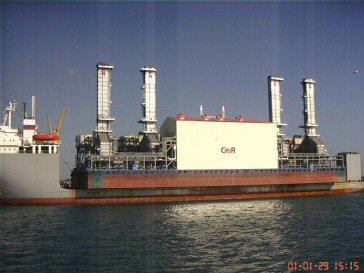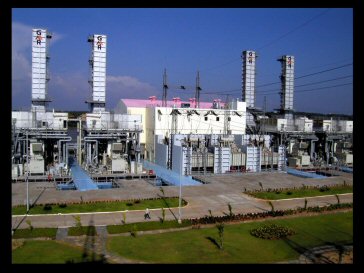|
| Plant Maintenance Resource Center
Open Warehouse System
| |
|
|
|
|
|
Open Warehouse SystemAuthor : H. Lakshminarayan
Plant Maintenance Resource Center Home Maintenance Articles
Introduction:Management today is never the same what was yesterday. And India, undoubtedly, has been one place that has witnessed radical changes in Management - be it Man Management, Money or Material Management. And it goes without saying that concept of "Lean" in all fields is the name of the game. Lean Organization, Reduced Vendor base, Shorter Production Cycle, Market Micro-segmentation and Skinned Distribution Points are all globally accepted jargons of the present day cost conscious world. The world's largest combined cycle power plant on a single barge, and, India's first and the only barge mounted power plant set up at Mangalore coast set up by GMR Group, a renowned name in Infrastructure Sector. The plant had all the traditional elements of Lean concept - A lean human organization structure, lean operation cycle, a single-segment raw material supplier and a single segment market for its Power. Add to this was the Open Warehouse System, Where many companies today try to squeeze costs too hard in trying to meet its own requirements, GMR aggressively promoted Open Warehouse System to ensure Accessibility to Operation and Maintenance Teams - thereby provide Product Reliability to end customer - Supply Power on Demand.
Traditional Hiccups:An oracle based ERP system put in place centrally integrating the entire Supply Chain Network. In an Open Warehouse System, the conventional Window-Issue system is replaced by "Take and Post" system where each member can take material but is expected to record (t)his (trans-) action in the ERP system, the lone Warehouse member providing value adding services such as Accounting, Auto Replenishments and key MIS to Top Management. In any case, authorized Heads would approve all such recorded transactions the same day. As is for any other industry, non-manufacturing units in particular, Material Indents for B class materials to some extent, and particularly C Class materials have been the maximum. Following is the indicative figures reflecting the phenomenon:
Traditionally, this pattern holds true everywhere, one may say. But troubled water begins here and trouble-shooting efforts stop there, as little effort is put on control of B and C class materials - control in the sense that efforts to ensure that ERP system is posted with right quantity of materials actually withdrawn. In other words, the system should always reflect realistic picture of current stock. You never know if/when any particular "B" or "C" class category is also "V" (Vital) or "E" (Essential) categorized. During the religious Annual Stock Taking ceremony, it was rightly observed that discrepancies in "B" and "C" class categorized materials was significantly very high, touching double digits! A Lo, the Open Warehouse System is deemed a complete failure? Back to traditional window-based issue system necessitated with rows and tiers reflecting clerical scenes? Re-Inventing Open Warehouse SystemThere were two fundamental issues to decide continuity of Open Warehouse System. One, Is missing inventory an advantageous exploitation of system in hand; and second, is physical discrepancies alone attributable to direct failure of Open Warehouse System. All O&M activities have been taken up against pre-approved O&M Schedule and pre-authorized Work Permits. An exhaustive review of the list of materials used against Work Permits during the year was carried out - And that was all that was required to be done to source missing materials and close each of the discrepancies observed. It was more than evident that advantageous exploitation of open warehouse system was not prevalent. And to look at discrepancies as part of industrial practice, are we satisfied by merely writing off the discrepant inventories, as is done in several other industries across the globe by prescribing their own benchmarked limits or can we work upon collaborative efforts to eliminate the discrepancies. TeamworkTeamwork is the key to success for a successful and workable Open Warehouse System. This was simply true as everyone from the Team realized the hindrances in a window-based closed warehouse system and that would in one way or other affect the speed, morale and reliability of pro-activeness in their functioning. Everyone from the Team also realized that each of them have mutually shared goals & objectives and their own added responsibilities to achieve them in unison.
For an Open Warehouse System to function, each member must have
Zero Indenting System [ZIS]Supply Chain Experts have devised ABC emphasizing on "A" categorized materials as a value-adding tool. If this holds good for Procurement or Consumption Control, then the utilization of this system to monitor & reflect realistic stock levels should be maximized. Zero Indenting System was introduced to facilitate members to take certain materials from warehouse without going through hassles of recording each transaction every time into the ERP system. Manual Registers were established where members were requested to write down details of materials drawn {Material Code, Quantity, Cost Center}. The materials would be recorded in the ERP system by Warehouse periodically - this is a parallel of auto-replenishment model. This exercise was however limited to Materials identified as ZIS materials. Materials covered under ZIS:1) All C Class Materials
It is clear from the above table that by implementing ZIS, we are able to cover up a high 82% of the physical inventory and at the same time, inventory control norms are restricted (not relaxed) only to 17% of the value, the major portion still has to go through the routine conventional model. The manual registers are auditable and periodic system updating is authorized by Maintenance Heads. In practice, the actual scope of ZIS can be made flexible based on System performance and the confidence levels of Maintenance Heads and the Warehouse. Perpetual Inventory Verifications [PIV]The successful establishment of Zero Indenting System was sufficient to boost the morale of every team member as it facilitated ease of working, but the probability of making the Open Warehouse System vulnerable still existed. To cement this, what was required was Perpetual Inventory verification. The Perpetual Inventory verification was introduced with following mandatory features:
The ZIS inventory was verified twice during a month, once every fortnight, to update consumptions in the system. The balance inventory was verified in parallel continuously. Accordingly, entire hundred percent physical inventories were verified over a span of two months with ZIS inventory verification a continuous affair. The above necessitated involvement of all team members without whom PIV or ZIS could not be possible. What was most important was sharing of information. Information must include that includes bad news, if any. If the bad news remains hidden in the warehouse bins, then there can be no real improvements. What followed during the next so-called religious annual physical verification audit was Stock tally with no discrepancies. To drive home the point, this was followed by series of external stock audits by agencies such as Price Waterhouse and Lending Institutions. There were in all six external audits over the next one year - audit schedule and audit scope of selection both at random, covering high risk, medium risk and low risk inventory areas. There have been no discrepancies. In summary, implementing the Open Warehouse System has been an excellent source of experience for each team member. The opportunity also saw the team to work together to drive home the point "With a little effort, we can indeed inculcate good team spirit even in an Open Warehouse" About the authorLakshminarayan has a Degree in Electrical Engineering (1992) and a Masters in Materials Management from Indian Institute of Materials Management (1995) besides Post Graduate Diploma in International Trade (1996). He secured an All India Second rank in Masters in Materials Management and awarded President Silver Medal. He also holds twelve years of experience from a Control Panel Manufacturing Industry, Secondary Metal Rolling Mill Industry, a Primary Metal Smelter Industry and presently heading the Supply Chain for an independent Power Generation Utility Plant. He has handled Supply Chain Management, Raw Material management; Strategic Project and Engineering Procurements/Purchases, Parts Management, Contracts Management, Imports - Global Sourcing, International Purchase Orders, Customs clearances, Logistics management - Incoming & Outgoing Materials Transportation contracts, Resource management & organization, Warehousing including Records, Space and Inventory management. During his career, he has implemented Just-In-Time for packaging materials in Secondary Metal Rolling Mill Industry, Zero Indenting System in Primary Metal Smelter Industry and Open Warehouse System in Power Generation Utility Plant.
Copyright 1996-2009, The Plant Maintenance Resource Center . All Rights Reserved.
| ||||||||||||||||||||||||||||||||||||||||||||||||||||||


